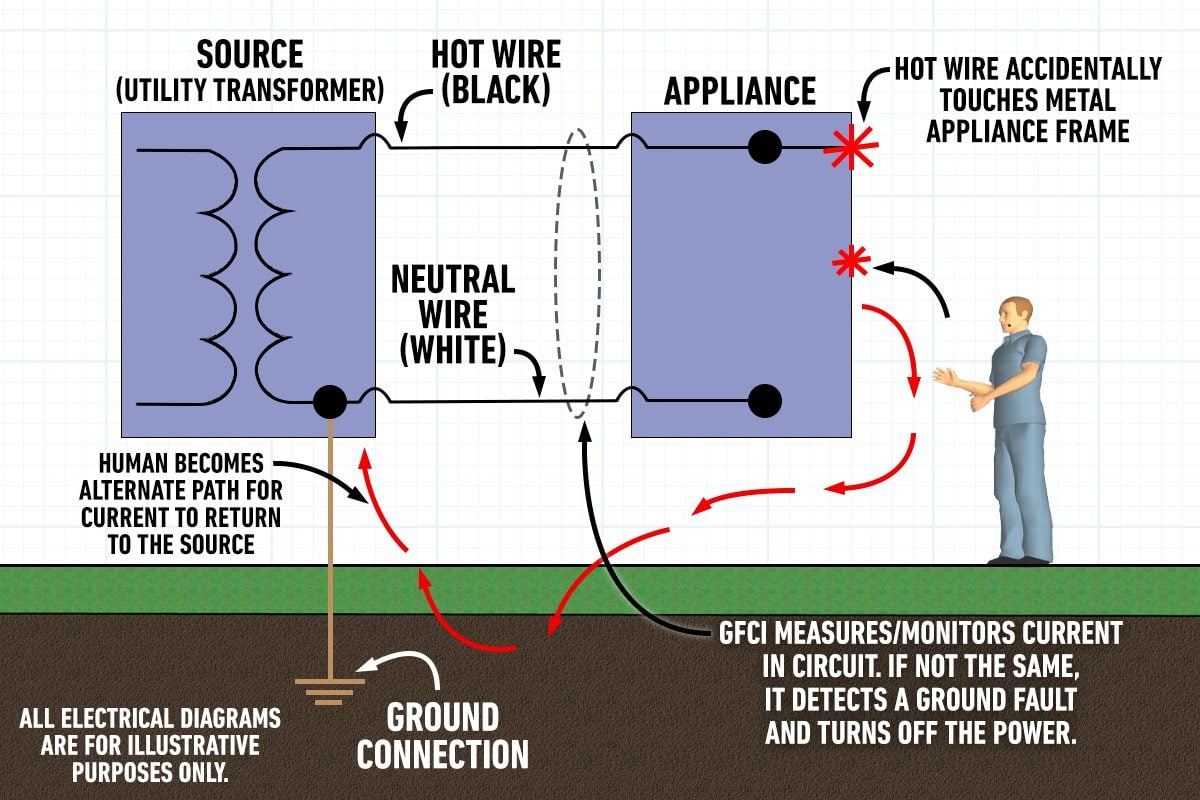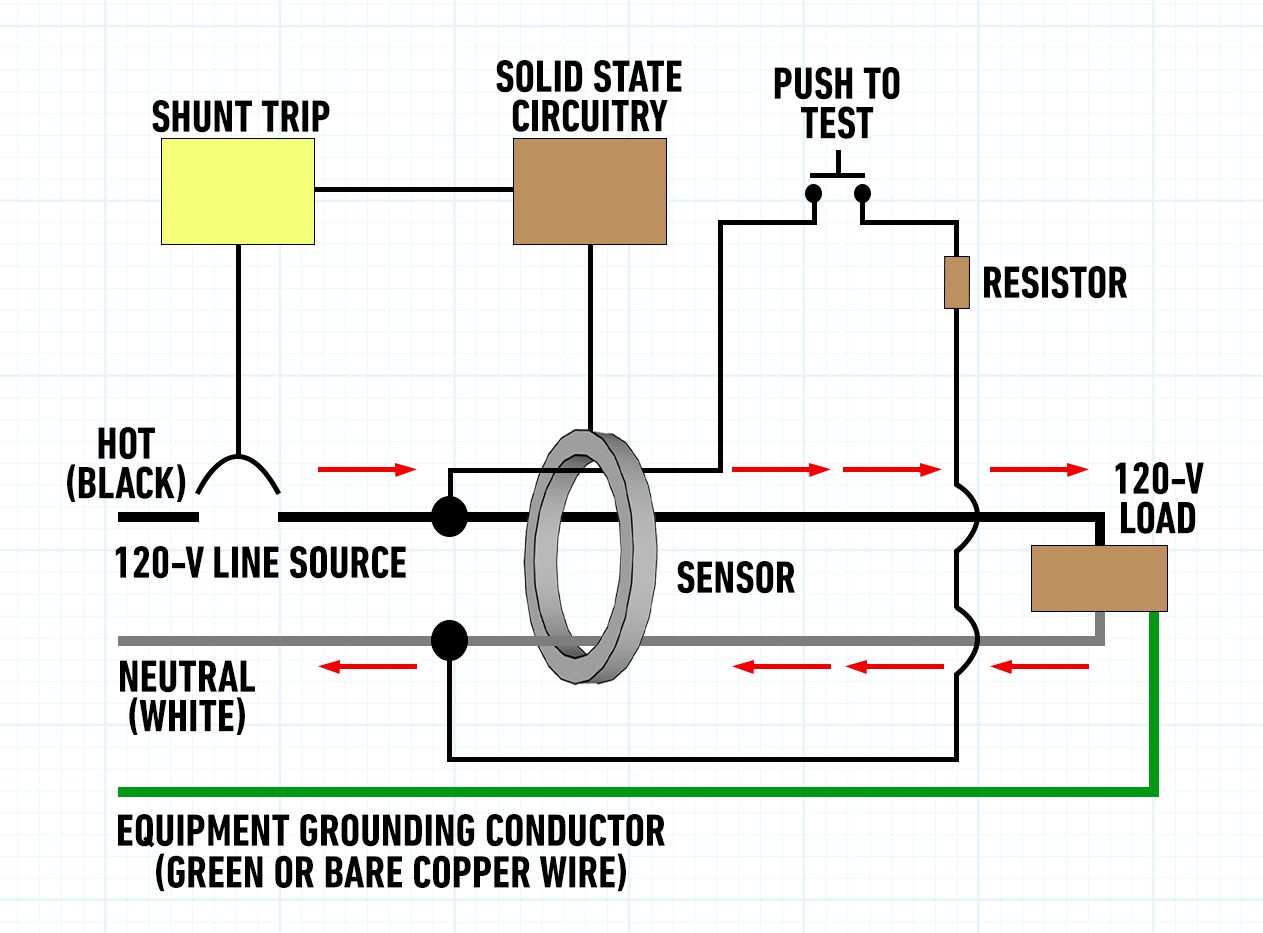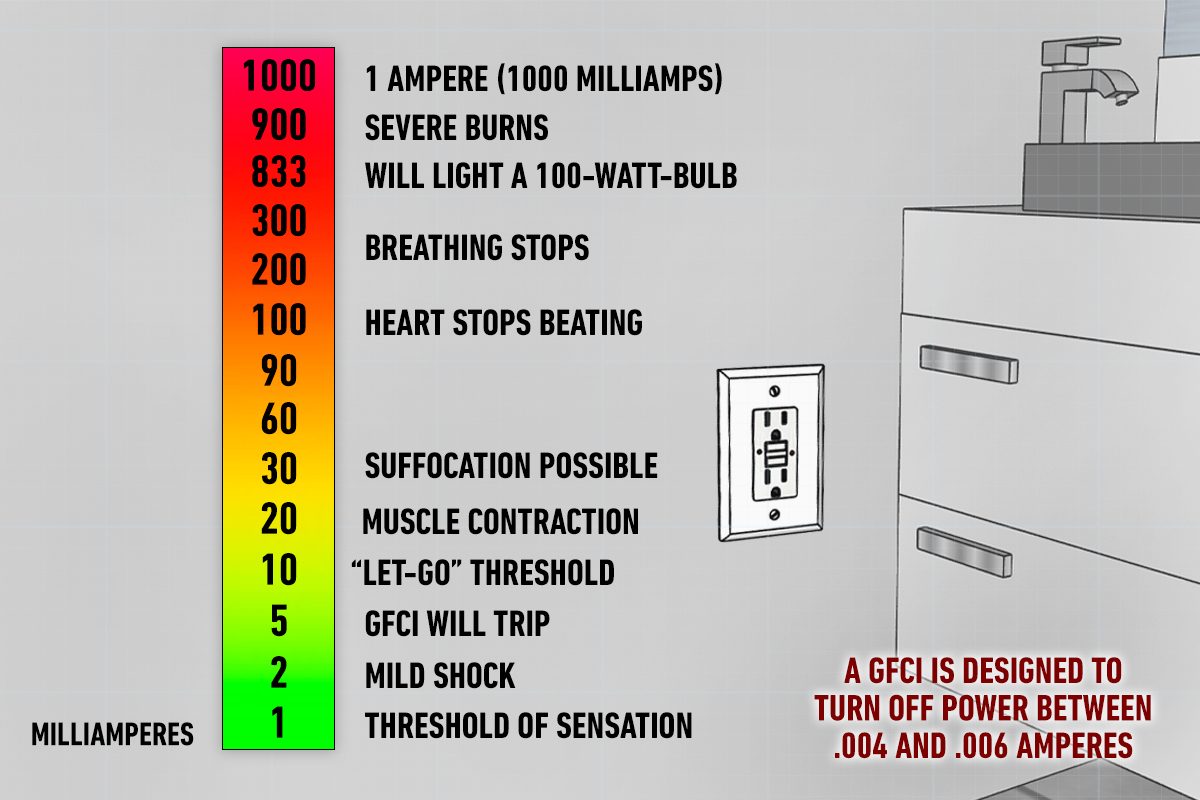I was a rookie apprentice electrician in 1978 when I received my first electrical shock.
Ground-fault circuit interruptor (GFCI) technology was new at that time, and we did not have GFCI-protected receptacles. I was kneeling on a damp concrete floor repairing some broken receptacles when my foreman in the adjoining room, thinking I was done, inadvertently turned the circuit back on. Bam!
I was momentarily stunned and petrified. I probably screamed. With help from nearby workers, I stood up and shook it off. My foreman felt terrible. We quickly created a safety plan to make sure something like that never happened again.
What Is a GFCI Protected Outlet?
A GFCI receptacle outlet, or GFCI protected branch circuit, provides protection from lethal electrical shocks.
GFCI protection is available in many forms, including:
- GFCI receptacles;
- GFCI circuit breakers;
- Blank-face GFCI devices;
- Portable GFCI devices and extension cords.
What Is a Ground Fault?

The National Electrical Code (NEC) defines a ground fault as “an unintentional, electrically conductive connection between an ungrounded conductor of an electrical circuit and the normally non-current carrying conductors, metal enclosures, metal raceways, metal equipment or earth.”
Translation: A ground fault happens when a hot wire comes in contact with something it’s not supposed to! Say, the metal exterior of your countertop microwave oven, or you, while standing in wet grass with a damaged extension cord in your hand.
How Does a GFCI-Protected Outlet Work?

Somewhere outside your home, an electric utility transformer reduces high-voltage power down to the 240/120 volts we put to work in our homes for appliances and lighting.
Like your favorite superhero, the utility transformer is the “source of all power.” Electricity leaves the source and must always return to the source. In simple terms, power flows to your appliances and lights via the black (or red) “hot” wire and returns to the source via the white “neutral” wire.
A GFCI constantly monitors the current in the hot and neutral wires at the same time. If the returning current in the neutral wire from the appliance is not exactly the same as the current in the outgoing hot wire to the appliance, then the GFCI detects a ground fault.
In other words, a portion of the current is trying to get back to the “source” by some other path than the neutral wire. And it could very well be through you, standing in the wet grass with that damaged extension cord.
The GFCI senses the ground fault, and in the blink of an eye shuts off the power to help prevent a lethal shock. Modern GFCI technology is required to stop the flow of electricity if the ground fault current is between .004 to .006 amperes, and before your heart starts beating erratically and causes death.

Where GFCI Protection Is Required in Your Home
All GFCI devices need to be in readily accessible locations, ensuring they can be reached quickly for operation and monthly testing. All 120- and 240-volt receptacles installed in the following locations must have GFCI.
Bathrooms
The NEC defines a bathroom as an area with a sink and one or more of the following: toilet, urinal, tub, shower, bidet or similar fixtures. It goes without saying, but water and electricity are a dangerous combination.
Garages, accessory buildings and boat houses
Garages, tool sheds and similar locations may have damp concrete, gravel or dirt floors. Any presence of water or moisture increases the potential for a shock hazard.
Outdoors
This is probably the most important category. After all, if you’re outdoors, you’re most likely in direct contact with the earth.
Crawl spaces and basements
Similar to garages and accessory buildings, damp concrete, dirt and gravel in crawl spaces and basements pose a shock hazard.
Kitchens
The presence of water and a multitude of appliances offer a higher risk of shock in kitchens.
Sinks
All receptacles within six feet from the top inside edge of the bowl of the sink require GFCI. That includes a wet bar sink. Many portable or hand-held appliances have six-foot cords, so the idea here is to ensure safety when using these appliances.
Bathtubs and shower stalls
Required on all receptacles within six feet of the outside edge of a bathtub or shower stall.
Laundry areas
There can be significant moisture and water in laundry areas.
Indoor damp/wet locations
This category is a catchall that covers other damp or wet areas that could pose an increased risk of shock, like a mudroom or an indoor greenhouse.
Crawl space lighting outlets
The GFCI requirement isn’t limited to receptacle outlets. All 120-volt lighting in crawl spaces must have GFCI. Crawl spaces often have dirt floors, increasing the shock hazard.
Specific appliances
The requirement for GFCI also extends to specific appliances, whether plugged into a receptacle outlet or direct-wired (hard-wired).
GFCI is required for branch circuits or outlets supplying the following appliances rated at 120 or 240 volts and 60 amperes or fewer: Sump pumps, dishwashers, electric ranges, wall-mounted ovens, counter-mounted cooking units, clothes dryers and microwave ovens.
Outdoor outlets
This is another catchall category. It applies to all outdoor outlets for cord-and-plug connected or direct-wired equipment supplied by branch circuits rated 120 or 240 volts and 50 amperes or fewer, including outlets in garages, accessory buildings and boat houses.
There are exceptions for snow-melting and deicing receptacles out of reach from the ground. There also is an exception for HVAC equipment, like an air-conditioner unit.
When Will Whole-House GFCI Protection Be Required?
Hard to say. The U.S. has been incrementally getting close to that goal. Many countries already have whole-house protection against ground fault leakage currents in an effort to prevent lethal electrical shocks.
Did you miss our previous article...
https://rsssuperfeeds.com/life-hacks/how-to-convert-your-regular-mattress-into-a-smart-bed






